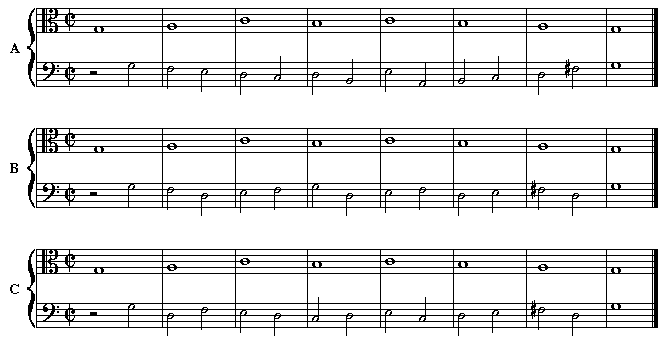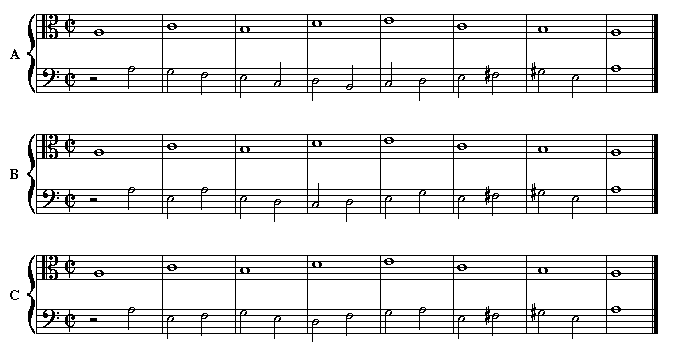SOUND PATTERNS
A Structural Examination of Tonality, Vocabulary, Texture,
Sonorities, and Time Organization in Western Art Music
by PHILLIP MAGNUSON

BASIC RULES FOR SPECIES COUNTERPOINT
Chapter 7. Species II in Two Voices
7.1 MELODIC PRINCIPLES FOR SPECIES II
-
The counterpoint moves two notes for every one
of the cantus firmus as in the example above.
-
The counterpoint begins on beat 2 (following a half rest).
This is how Species II melodies will look at the beginning.

-
The last measure will be whole notes in both voices.
This is how Species II melodies will look at the end.

-
Do not leap upward to beat 1 within an ascending line, unless
prepared. Upward leaps to beat 2 are allowable.
A prepared leap is one in which the upper note does not
sound suddenly new.
High notes create a tonic stress. Do not allow a tonic stress to coincide with a metric stress.

-
Do not leap tritones, or outline A4ths, or place A4ths on successive
strong beats.
Just as with Species I, diaboli in musica are historically incorrect.

-
Do not use motives or sequences (repeated melodic patterns).
Notice the descending pattern in this incorrectly constructed melody.

-
The musica ficta may occur on either beat. Do not leap into musica ficta with an interval larger than a third.
-
All other melodic principles are the same as for Species I.
INTERLUDE 1
Click on the letter of the line that uses Species II correctly.

7.2 CONTRAPUNTAL PRINCIPLES FOR SPECIES II
-
Beat 1 of every measure must be consonant.
-
Beat 2 may be either consonant or dissonant. If dissonant, it must be a passing tone (stepwise motion between two notes a third apart).
This is the proper context and labelling of passing tones.

Note that dissonances are circled. A4's and d5's will also have a line drawn through them to make it clear that they are not perfect intervals.
-
Unisons are allowable on beat 2, but be careful not to cross or
overlap voices.
Unisons bring the voices close together; they have to be
used in the context of contrary motion.

INTERLUDE 2
Click on the letter of the counterpoint that uses Species II correctly.

-
Do not use parallel perfect consonances from beat 2 to
beat 1, or from beat 1 to the next beat 1.
Since there are two notes in each measure, there are more
opportunites to create parallel perfect consonances.

-
Perfect consonances are always allowable on beat 2 since the cantus firmus does not move (oblique motion).

-
Do not use direct perfect consonances from beat 2 to beat 1.
Direct perfect consonances can only happen when both voices
are moving in the same direction.

-
All other contrapuntal principles are the same as for Species I.
INTERLUDE 3
Click on the letter of the counterpoint that uses Species II correctly.

7.3 EXAMPLE OF COUNTERPOINT IN SPECIES II

Note the F# used in measure 10; it is done to avoid the interval of an A2 to the G#. This is required in the Aeolian mode, and ONLY in the Aeolian mode.
ASSIGNMENT:
SYNTHESIS
Using an assigned cantus firmus, write a soprano counterpoint
above, and a bass counterpoint below, in Species II.
This must be written as two separate pieces, one with a treble clef and alto clef, and a second with alto clef and bass clef. Follow the exact format of the example above, including the labels for the counterpoint and the cantus firmus.
Be careful to pay attention to all the principles of Species II. especially while writing a melodic line, and make sure that any dissonances are truly passing tones.
Cantus firmi
1. |  |
|---|
2. |  |
|---|
3. |  |
|---|
4. |  |
|---|
5. |  |
|---|
6. |  |
|---|
7. |  |
|---|
8. |  |
|---|
9. |  |
|---|
10. |  |
|---|
11. |  |
|---|
12. |  |
|---|
Links to chapters in this unit:
Link to previous unit: FUNDAMENTALS
Link to next unit: DIATONIC PROCEDURES I: Harmonic Dimensions
Copyright © 2008-2009 by Phillip Magnuson.
Content on this website is licensed under a Creative Commons License.

























